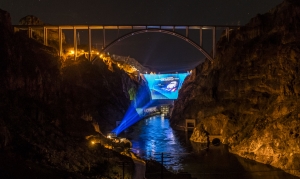- The curved wall of the Hoover Dam acted as the nation’s largest ever projection screen for the launch of Freightliner Inspiration, an autonomous truck from Daimler Trucks North America (DTNA). Creative Technology teamed with digital design and technology company dandelion+ burdock for the event, which featured five 4x4pro media servers from d3 Technologies driving video, graphical and IMAG content on the expanse of the dam wall.
The end product of the Hoover Dam visualization effort.
One of the top ten engineering marvels in the world, Hoover Dam was built during the Great Depression on the Colorado River on the border of Arizona and Nevada. The massive concrete arch-gravity dam impounds Lake Mead, the largest reservoir in the US by volume, and is a popular day trip from Las Vegas.
The site was chosen to debut the Freightliner Inspiration truck, the first licensed autonomous commercial truck to operate on an open public highway in the US, to an audience of international news media, trucking industry analysts and officials. Autonomous vehicle technology promises to reduce accidents, improve fuel consumption, cut highway congestion and safeguard the environment.
OSK Communications conceived the Freightliner Inspiration launch with production management specialists SIAM Productions producing the overall event. SIAM partnered with Creative Technology (CT) to bring the project to life with the expertise of d3 specialists dandelion+ burdock.
The challenges were enormous: the 420,000 square-foot surface had a number of different angles of curves to it and was half-a-mile away from the projection tower, which featured 60 projectors synchronized to create a single seamless image with a resolution of over 4000 horizontal pixels.
Nils Porrmann, director and founding partner of dandelion+ burdock, has been working with d3 Technologies for a decade, first as a content designer then on live events, including the now iconic Polo Ralph Lauren projection. dandelion+ burdock is well known as a d3 studio and the place to go for special event projects.
“I’ve worked with Herb Brandt (general manager of CT’s Las Vegas office) and Marty on a number of projects; we have a big mutual respect for each other’s skills,” says Porrmann. “The 4x4pros first and foremost gave the content team and Ben Keightley, the d3 sequencing artist and operator, the most flexibility. We output the 4K x 2K textures onto the dam but overlaid them multiple times and composited effects. This was a big gain in freedom for content production.”
The Freightliner Inspiration launch opened with a preproduced video projected onto the dam. Next, DTNA spokespeople were supported by IMAG; a prereveal video followed. Then the innovative new truck made its drive down onto the road atop Hoover Dam with live camera shots of the vehicle projected onto the dam.
Multiple site visits were required to find the best location for the projection tower and the d3 media servers. CT tested multiple spots including the shoulder of the bypass bridge and the base of the power plant before discovering the eventual projection location nearly half a mile down river from the face of the Dam. “It was a much friendlier space,” notes Henning. “We didn’t have to access it through a security tunnel, it was less intrusive for a site that’s open 24/7, and there was no 70 mph traffic on it, and it was on a perpendicular axis to the dam face.”
In prepro a basic 3D model of the dam, based on a limited data set, coupled with satellite imagery enabled Porrmann to use photogrametry to construct a draft model. Later, a laser survey crew on site precisely measured distances and angles to update and adjust the existing 3D dam model. The model was ingested into the d3 media server to previsualize the projector positions relative to the dam and show “what we could expect from rock and canyon shadows,” Henning says.
CT specified 60 Barco projectors, both W26 26,000-lumen and W20 20,000-lumen models,. The output of the projectors generated a 1.17 lumens – an official Guinness world record among projections. Bob Loney of Tekamaki was the senior projectionist working with a projection crew of ten.
All five of CT’s d3 4x4pros were deployed at Hoover Dam. “We ran the system in a fully redundant configuration. To minimize the signal transmission distance, the servers were staged with the projectors, except for one unit used as an editor to allow the show programmer to work in the space with the show director and content team.” Henning explains.
“Due to the power of the server we were able to put all ten channels on a single server and not worry about performance issues,” he points out. “That made is much easier than having to divide the channels across multiple servers.”
Porrmann used d3’s QuickCal feature to calibrate ten key projectors in the stacks. “The remaining 50 projectors were siblings that were aligned by projection,” he says. “I’ve been using QuickCal for a long time now – it’s an indispensable feature.”
Henning hails the 4x4pro’s new 10Gb network capabilities, which permitted the team “to transfer content in a matter of minutes instead of hours.” Porrmann agrees. “Using the new 10Gb data distribution allowed us to have an editing server with the camera and show direction team,” he says. “All contents were loaded there and came to us, at the projection tower, via fibre. We ended up copying 130Gb in about nine minutes, even with a mile of fiber between computers.”
The 4x4pros’ minimal latency also meant that, “we brought in the live video inputs without a horrible lag,” says Henning. “There were eight cameras on the shoot to cover the truck reveal on the road across the top of the dam. They included cameras in a helicopter and chase car and a Steadicam on the dam itself.”










